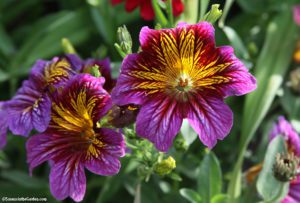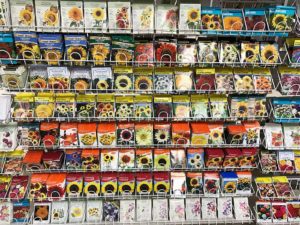March 19 Column: Cut-Flower Garden

I can’t believe it’s time for my 5th column and video already! Today’s topic is about growing a cut-flower garden. This is something that is great fun because flowers are easy to grow and they will provide you with so much beauty both in your garden and indoors. Here’s a link to my column in today’s edition of The Spokesman-Review: Flowers bring beauty and pollinators to the garden. (or you can read my column lower in this text)
As I mentioned in my column, my “official” cut-flower garden will be comprised of annuals. Why? I’m dedicating a raised bed in the middle of my vegetable garden for it, and if I grow annuals (plants that grow, bloom, set seed and die in a single growing season), I can try different ones every year.
While it’s not time to plant annuals yet, since they aren’t cold-tolerant, it’s certainly time to do a little research to decide which ones you want to grow, figure out where you’re going to plant them, and either get the seeds growing indoors right away… or decide where you’re going to purchase some locally.
The best time to plant annuals is after all danger of frost is past. Here in the Inland Northwest, that’s typically after mid-May. Of course, you have to keep an eye on the weather forecasts, too, just to be safe!
Indoors, I’ve started zinnias, celosia, Gloriosa daisies and cosmos. I will also plant ‘Peach Passion’ and ‘Van Gogh’ sunflower seeds right into the garden bed in mid-May since they seem to do better that way, rather than planting them indoors first.
Here is a link to this week’s “Everyone Can Grow A Garden!” video. In it, I’ll show you where my cut-flower garden is going to be planted and a slideshow of some of the amazing annuals that I mentioned in my column so you can get a little inspiration!
And before I forget: if you live in the Spokane area and are looking for seeds, Northwest Seed & Pet has a huge selection of flower, vegetable and herb seeds. I don’t receive anything from them for mentioning this, but they carry many different brands of seeds, so check with them first to see if they have the ones you’re looking at online.
Garden column about cut-flowers:
by Susan Mulvihill
While I’m a huge proponent of growing vegetables, flowers should be present in everyone’s garden. First of all, they provide us with beauty both outdoors and in our homes. But they also attract and feed pollinators.
This year, I’ll be growing a small cutting garden right in the middle of my vegetable garden. Cut flowers are often a blend of perennials, bulbs and annuals, but I’m focusing on annuals so I can try different plants every year. Why not grow one in your garden, too?
Our local greenhouses are great sources for bedding plants or you can start yours from seed. After perusing many catalogs, I’ve come up with a list of wonderful candidates:
Susan’s cut-flower garden picks:
Ageratum _ While most gardeners are familiar with more compact types, look for long-stemmed cultivars such as Blue Planet, Blue Horizon, Red Sea, and Dondo Blue or White.
Asters _ The blossoms of annual asters are typically white, pink and purple, with single or double flower heads. Crego or Powderpuff are good choices.
Bachelor’s Buttons _ Also called cornflower, they have long stems and flowers in shades of blue, white, salmon pink or burgundy. Try Tall Blend, Black Magic or Black Ball.
Celosia _ Spiky flower heads add interest to floral arrangements. Flamingo Feather ranges from dusty pink to bright magenta while Forest Fire is bright red.
Cosmos _ For pastels, choose Sea Shells, Sensation or Double Click, and for hot colors, try Bright Lights. The plants have attractive, lacy foliage.
Dahlias _ Two options are brightly-colored annual bedding plants, such as Unwin’s Mix, or dahlias grown from tubers, which are available in limitless color combinations. Both types are wonderful in arrangements.
Gloriosa daisies _ The bright, perky colors of these daisies can’t be beat and they make wonderful cut flowers.
Globe Amaranth _ I love the fluffy flower globes, which come in delightful colors. Consider [spelling is correct] Audray Pink or Purple Red, Ping Pong Lavender or Purple, and Strawberry Fields.
Larkspur _ While my favorite is the deep blue, they are also available in lavender, white and pink. Shades of Blue, Imperial Blue and Giant Imperial are very appealing.
Painted Tongue _ Also known as Salpiglossis, this old-fashioned, trumpet-shaped flower is a showstopper since its petals look hand-painted in shades of pink, peach, yellow and apricot.
Salvia _ The most common bedding plants are Blue Bedder, Victoria Blue and Clary Blue. Also look for the taller Black and Blue, Coral Nymph and Amistad, with their beautiful foliage. All attract hummingbirds.
Snapdragons _ Even though this plant triggers childhood memories for most of us, many new flower types and colors take them to a whole new level.
Statice _ If you’re looking for dried flowers, these plants feature petite white, purple, yellow and dusty rose blossoms.
Stocks _ I love stocks for the clove-like scent of their blossoms. The attractive, pastel-colored flower spikes of Giant Imperial Mix make them even more desirable for your garden.
Sunflowers _ To avoid tipping over a vase, select small-headed cultivars such as Italian White, Van Gogh, Valentine, Royal Flush, Peach Passion, Autumn Beauty and Garnet Star.
Zinnias _ One of the best cut flowers, zinnias are available in many colors and flower types. Add some pizzazz to your garden with Persian Carpet, California Giants, Green Envy, Polar, Queen Red Lime, Dancing Girls, State Fair and Starlight Rose.


